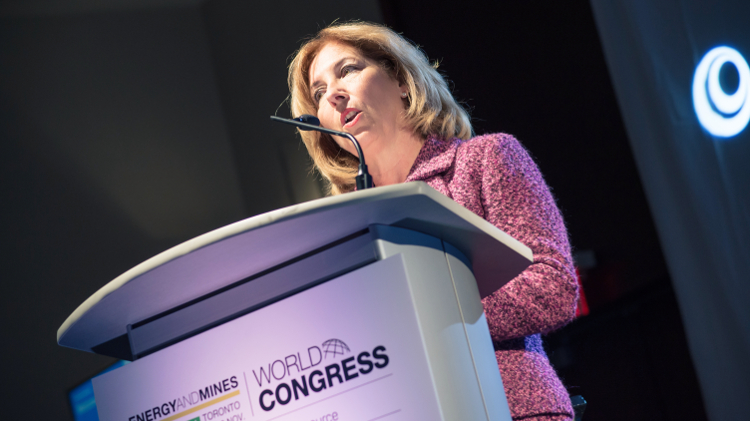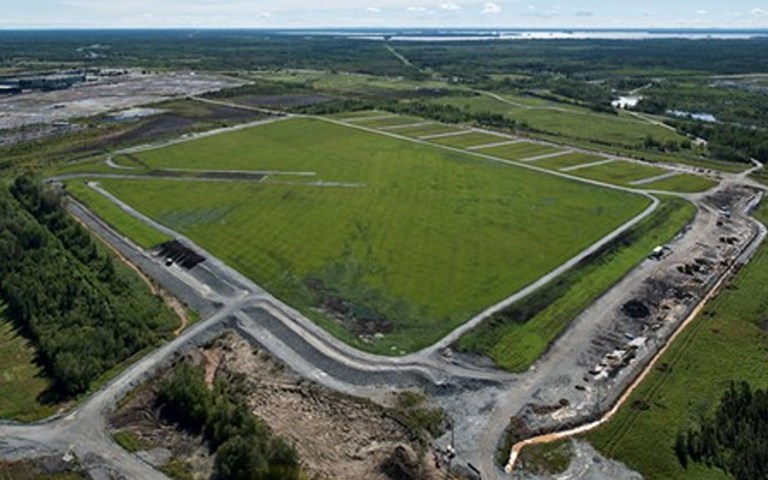The jarosite pond area after reclamation | Courtesy of Glencore Canada
The jarosite pond and the area around it at Glencore’s Kidd Metallurgical site (Kidd Metsite) in Timmins, Ontario was an eyesore three and a half years ago. More than 800,000 tonnes of jarosite, an iron sulphate byproduct of refining zinc ore from the nearby Kidd copper-zinc mine, covered 30 hectares, an area the size of 56 football fields, with brown and red water and sludge.
Flash forward to 2014, and today the area resembles what it used to look like in the days before industry: an open green meadow. For its work reclaiming the pond and the area around it, Glencore Canada Corporation won the 2014 Tom Peters Memorial Mine Reclamation Award, handed out every year by the Canadian Land Reclamation Association and the Ontario Mining Association in recognition of the best mine cleanup work in Ontario.
Kidd Metsite was mostly shut down when zinc and copper smelting ceased in May 2010 and the bulk of its buildings were dismantled. However, the concentrator at the site continues to process ore from the Kidd mine, 27 kilometres away.
The pond was built in 1971 and, during the very early years, some seepage from the containment area into nearby Three Nations Creek was detected and quickly contained. Over the life of the site, there was continuous monitoring and additional upgrades were made including the construction of seepage collection ditches, pump-back systems, and stabilization berms.
“When closure of the jarosite pond began in 2010, the pond had been stable for the majority of its years in use,” says David Yaschyshyn, Kidd Operations’ environment manager.
Building on mud
The closure of the jarosite pond, including the dewatering of the sludge and the covering of the remaining material, posed a challenge as this waste had the consistency of mud, making it difficult to build on or over. “Part of the challenge for our project design partner, AMEC Environment & Infrastructure, was to establish a surface upon which we could install the final covering,” explains John Stroiazzo, Glencore Canada’s manager of reclamation and projects. “To create this stable platform across the pond area, we used waste rock obtained from a nearby gold mine.”
Next, the team installed a massive liner out of thousands of sheets of 60-millimetre-thick black high-density polyethylene welded together to create what Yaschyshyn describes as a massive quilt. Wind was a constant nemesis, however. On breezy days, a crew of 12 to 15 workers would use sandbags to hold down the sheets as they were welded together. On very windy days, work on the liner stopped completely. The team checked every weld for integrity, Yaschyshyn says.
Finally, the crew added a layer of soil almost one metre thick. The soil itself was augmented with municipal biosolids – dehydrated human waste culled from sewage treatment plants in Toronto and Ottawa. “The nutrients in the biosolids were readily available,” Yaschyshyn says. “It’s like putting Miracle Gro on your garden.” Though the idea of using biosolids may make some squeamish, they are safe and non-toxic by the time they are applied, and pose no danger to the environment according to Glencore.
The approach of using biosolids as fertilizer in farming and reclamation work is one being promoted by the Ontario government, says Stroiazzo. He adds that using biosolids has an added benefit: “It comes at a very good price: it’s free. The vegetation over the former pond grew quickly and flourishes to this day.”
The result is a lush green meadow and the return of an industrial waste site to something approaching a natural state. Even so, Yaschyshyn says the site will still be monitored for ongoing care and maintenance of the vegetation, which cannot include trees because root systems could damage the liner. “Financial provision has been made for this long-term monitoring and maintenance,” he adds.
A thriving ecosystem
Although not so impacted by the nearby industrial activity that it required full remediation, Glencore Canada still included Three Nations Creek, located slightly downhill from the jarosite pond, in the multi-million dollar remediation project. The concentration of metals in the creek’s water would rise and fall seasonally as soil and sediment containing some metals, particularly zinc, would dry out then wash into the creek during heavier rains. “Prior to the project, the creek was already relatively healthy with all kinds of fish and invertebrates living in it,” says Yaschyshyn.
Stroiazzo says the company considered a range of options, from leaving the relatively healthy creek untouched to completely removing the creek bed. The final remediation plan consisted of a series of dams and ditches that raised the water level in the creek to ensure the water cover was maintained to keep the soil and sediments from drying out. This was accomplished by creating a 10-hectare wetland as part of Three Nations Creek.
As a result, the presence of zinc in the water no longer spikes after a dry season and has declined yet another order of magnitude, now regularly below provincial water quality objectives.
“Creating this wetland provided for a more sustainable way to manage the nearby ecosystem,” says Yaschyshyn. “Not only does this wetland help prevent the drying of the soil in summer and its washing away into the creek during the rainy season, but it also includes a network of passageways designed to allow fish to move up and downstream unencumbered.”
“Three Nations Creek is a thriving ecosystem,” concurs Stroiazzo.
The complete project, which employed as many as 50 workers, cost more than $50 million and was deemed a success as attested by Glencore Canada’s recent win of the Tom Peters Memorial Mine Reclamation Award.
“Although we are still in active operation with a mine, concentrator and tailings area, this project is an example of how we will undertake future closures at our site,” says Yaschyshyn. “We have set the bar high and are committed to the same level of effort to minimize our impact on the environment while in operation and to remediate our site as we approach closure.”
For Stroiazzo, the project is an example of good planning and use of easily available local materials, whether it be waste rock or fertilizer made from human excrement. “It established a methodology of using what you have, where you have it to minimize your impact to the environment in other ways,” he says. “There was a lot of clever thinking to bring this together at a reasonable cost.” With closure plans and remediation deposits mandatory just about everywhere these days, Stroiazzo says the best practices learned at Kidd Metsite are valuable for Glencore Canada.
And of course, there is the simple pride of being recognized for a job well done. With 32 years of experience in mine cleanup, Stroiazzo is used to working behind the scenes, although his cleanup project for another decommissioned Glencore site, the Gaspé copper mine in Murdochville, Quebec, also won an award in 2011. Still, he says, “These are big jobs. They take a lot of time and energy. They’re not always visible and to get recognition for projects like this is very satisfying.”




